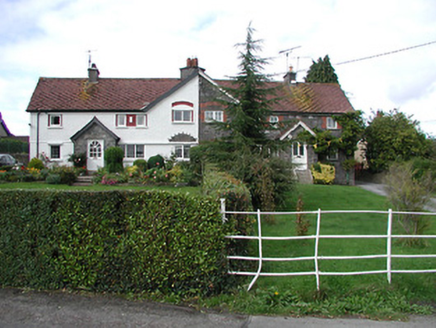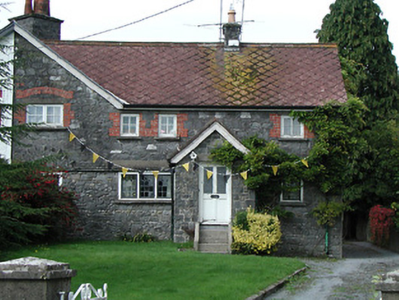Survey Data
Reg No
12308026
Rating
Regional
Categories of Special Interest
Architectural, Historical, Social
Original Use
House
In Use As
House
Date
1895 - 1900
Coordinates
249654, 158037
Date Recorded
10/08/2004
Date Updated
--/--/--
Description
Semi-detached four-bay two-storey Arts-and-Crafts-style foreman's house, built 1896-9, originally thatched with single-bay single-storey gabled projecting porch, and shared single-bay two-storey gabled end bay to left. Reroofed, c.1950. One of a pair. Pitched (shared) roof (gabled to porch; gabled to end bay) with replacement clay tile, c.1950, laid in diagonal courses, terracotta ridge tiles, rendered and cut-limestone diagonal (shared) chimney stacks, timber bargeboards, and cast-iron rainwater goods on timber eaves. Random rubble limestone walls (probably originally rendered with render removed, pre-2000) with dressed limestone quoins to corners to porch. Square-headed window openings with cut-limestone shallow sills, red brick block-and-start surrounds to first floor, timber casement windows having leaded glazing with one to ground floor having rubble limestone dressings forming segmental overpanel, and one to first floor having red brick dressings over forming camber relieving arch. Square-headed door opening with four steps, cut-limestone lintel, and glazed timber panelled door. Set back from road in own grounds with landscaped grounds having wrought iron railings to perimeter of site.
Appraisal
A pleasantly-composed modest-scale house built as one of a pair (with 12308007/KK-19-08-07) forming an important element of a planned village built for Ellen Odette Desart (née Bischoffsheim), fourth Countess of Desart (1857-1933) to a master plan devised by William Alphonsus Scott (1871-1921). Exhibiting a number of distinctive attributes redolent of the Arts-and-Crafts style features such as the fine detailing throughout employing a variety of materials enhance the architectural design value of the composition. Having been reasonably well maintained the original form and massing survive intact together with most of the historic fabric, thereby contributing positively to the character of the collective complex.



